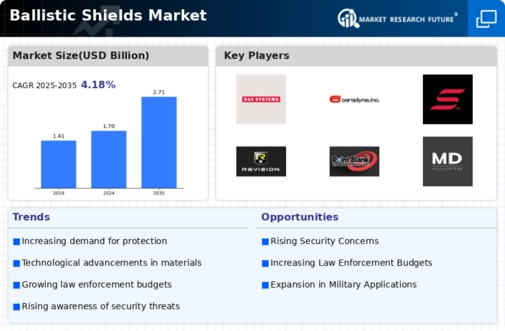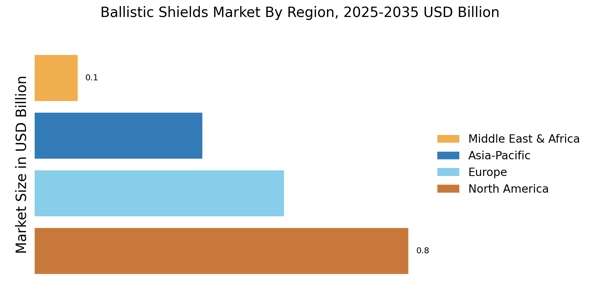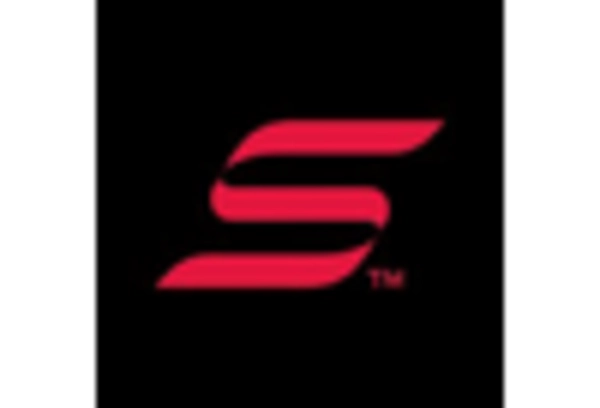Rising Security Concerns
The Ballistic Shields Market Industry is experiencing a notable surge in demand due to escalating security concerns across various sectors. Heightened threats from terrorism, civil unrest, and violent crime have prompted governments and organizations to invest in protective equipment. According to recent data, the market for ballistic shields is projected to grow at a compound annual growth rate of approximately 5.2% over the next five years. This growth is driven by the need for enhanced safety measures in public spaces, schools, and workplaces. As a result, manufacturers are focusing on developing advanced ballistic shields that offer superior protection while remaining lightweight and portable. The increasing awareness of personal safety is likely to further propel the demand for ballistic shields, making it a critical driver in the Ballistic Shields Market Industry.
Growing Civilian Market Demand
The Ballistic Shields Market Industry is witnessing a growing demand from civilian sectors, particularly in areas such as personal security and corporate safety. As awareness of personal safety increases, individuals and organizations are seeking protective solutions that can mitigate risks associated with potential threats. Recent surveys indicate that a significant percentage of businesses are investing in security measures, including ballistic shields, to protect employees and assets. This trend is further fueled by the rise in active shooter incidents and other violent events, prompting a proactive approach to safety. Consequently, manufacturers are expanding their product lines to cater to civilian needs, offering shields that are not only effective but also aesthetically appealing. The increasing acceptance of ballistic shields in civilian applications is thus a vital driver in the Ballistic Shields Market Industry.
Focus on Training and Education
The emphasis on training and education within the Ballistic Shields Market Industry is becoming increasingly apparent. Organizations are recognizing the importance of equipping personnel with the knowledge and skills necessary to effectively utilize ballistic shields in high-stress situations. Training programs are being developed to ensure that users understand the capabilities and limitations of their equipment, thereby enhancing overall safety and effectiveness. Additionally, educational initiatives aimed at raising awareness about the benefits of ballistic shields are gaining traction, particularly among law enforcement agencies and security firms. This focus on training not only improves user confidence but also fosters a culture of safety within organizations. As a result, the commitment to training and education is likely to drive demand for ballistic shields, reinforcing its significance in the Ballistic Shields Market Industry.
Government Initiatives and Funding
Government initiatives aimed at enhancing public safety are significantly influencing the Ballistic Shields Market Industry. Various countries are allocating substantial budgets to law enforcement and military agencies for the procurement of advanced protective gear, including ballistic shields. For instance, recent reports indicate that defense budgets in several nations have increased, with a focus on equipping personnel with state-of-the-art protective equipment. This trend is expected to continue, as governments recognize the importance of safeguarding their citizens and personnel. Additionally, public-private partnerships are emerging, facilitating the development and distribution of innovative ballistic shield technologies. Such initiatives not only bolster the market but also encourage research and development, leading to improved product offerings. The infusion of government funding is thus a pivotal driver in the Ballistic Shields Market Industry.
Technological Innovations in Design
Technological innovations are reshaping the Ballistic Shields Market Industry, as manufacturers strive to enhance the performance and functionality of their products. Advances in materials science have led to the development of lighter, more durable ballistic shields that provide superior protection without compromising mobility. For example, the integration of composite materials and advanced polymers has resulted in shields that are both effective against ballistic threats and easier to handle. Furthermore, innovations such as modular designs allow for customization based on specific operational needs, appealing to a broader range of users, including law enforcement and military personnel. The continuous evolution of technology in shield design is likely to attract new customers and expand market reach, making it a crucial driver in the Ballistic Shields Market Industry.


















Leave a Comment